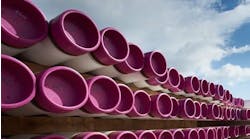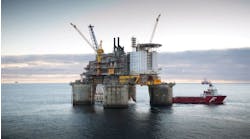Y allows bi-directional pigging
Judy Maksoud
International Editor
Oran Tarlton
Oil States
Flowline intervention is nearly a given over the life of a large producing field. Because intervention, particularly in deepwater, can be costly, operators are always on the lookout for ways to minimize the intervention costs. Oil States has just provided another option.
A new alternative
The new fitting developed by Oil States does not include any truly "new" technology; instead it improves existing technology for a new use, according to developers. The Intervention Y fitting is manufactured from either a forged or cast body from pressure vessel quality materials. The fitting is machined so the flow path through the Y matches a 5D radius instead of the conventional 30° angle. The Y fitting has no depth limitation and allows coiled tubing to be introduced into the flowline while under pressure.
With a diverter plug in place, the bore through the Y fitting is a true 5D bend, which allows virtually any pig, including an intelligent pig, to pass through the Y fitting as easily as if it were passing through a true 5D bend of pipe. More significantly, a pig can be run in either direction through the Y fitting. Bi-directional pigging is a unique feature of the Intervention Y fitting.
The intervention bore allows access into the pressurized cavity of the Y fitting through a block valve. The plug is installed or removed using a plug insertion and removal tool (PIRT). The PIRT can be installed and operated subsea by a diver or ROV or can be operated topside via an umbilical.
When the PIRT is connected to the block valve, pressure is equalized between the PIRT and valve so the valve can be opened, allowing the diverter plug to be installed or removed from the fitting while the flowline remains pressurized. With the diverter plug recovered in the PIRT, the block valve can be closed, and both the plug and PIRT can be recovered to the surface. Finally, the coiled tubing stuffing box can be installed on the valve so an intervention can be performed. Replacing the plug is a straight forward reversing of this procedure.
When hydrates, paraffin formations, or mechanical blockages restrict flow, the diverter plug can be removed with the flowline in service. Then, coiled tubing can be introduced through the intervention branch to remove the obstruction and allow resumed full flow in the line.
There are two types of PIRTs available. One is fully hydraulic. The other is a hydraulic mechanical version that runs lead screws so that it can withstand the full thrust load of an impact if a blockage is suddenly released. This option is only critical if an intervention is to be performed with the flowline under full operating conditions.
null
Installation
The Intervention Y fitting can be placed on the topsides, as installed on the Thunder Horse semisubmersible and Matterhorn TLP, or subsea, as installed on the Na Kika semisubmersible. The Intervention Y can also be installed in manifolds and pipelines to facilitate easier subsea intervention. The location and number of installations is a matter of operator choice and intervention philosophy. The location of the fitting dictates the point of access for coiled tubing intervention. Judicious location of the fitting maximizes the range of pipe for coiled tubing intervention.
Topsides placement provides the easiest access for coiled tubing because the process can be carried out without a diver or ROV. The advantage of subsea placement is that the fitting allows an intervention at locations beyond the reach of surface-introduced coiled tubing. In some situations, topside access is so restricted that the range of the coiled tubing is limited because of the number of bends the coiled tubing has to pass through. Each time coiled tubing makes a bend, the distance the tubing can be run is reduced. By placing the Intervention Y fitting subsea, all of the topside bends are eliminated, which extends the distance coiled tubing can be run.
null
A third option for installation is in a manifold, though none of the fittings has yet been placed in a manifold. The advantage of manifold installation is greater coverage of multiple pipelines.
In any case, installing the Intervention Y fitting is a form of insurance that makes resolving a flow assurance problem far less expensive. If no flow assurance issues arise during the life of the pipeline, the cost of the fitting would not be recovered. If a problem does arise, the cost of remediation is dramatically reduced through the use of this pre-installed tool.
Intervention Y in operation
The first Intervention Y fitting was installed in 2003. To date, there are 11 installed in deepwater developments in the Gulf of Mexico, including four on Shell's Na Kika, five on BP's Thunder Horse, and two on Total's Matterhorn.
The Intervention Y fittings have been manufactured in 8-, 10-, and 12-in. bore sizes with pressure ratings to 5,000 psi, 10,000 psi, and 12,500 psi. Each intervention Y has a 5-in. nominal plug bore, though the intervention bore can be the same size as the primary bore to facilitate specialty coiled tubing requirements. Several Intervention Y fittings have been provided without plugs because there was no anticipated need for bi-directional pigging. There does not appear to be an engineering or manufacturing limitation to building Intervention Y fittings up to 24 in., but none of that size has yet been required. Though none of the fixtures has yet been used for remediation, it is only a matter of time before the technology is put to the test.





